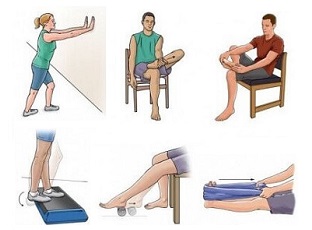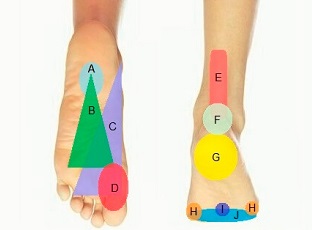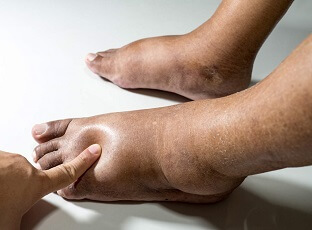- Home
- Common Foot Problems
- Sesamoiditis
Sesamoiditis Foot Pain
Written By: Chloe Wilson BSc(Hons) Physiotherapy
Reviewed By: FPE Medical Review Board
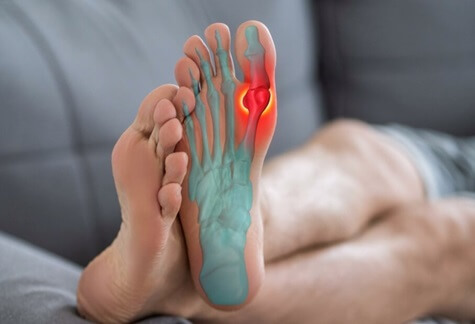
Sesamoiditis is an overuse injury that results in pain underneath the big toe.
The foot sesamoid bones are two small round bones that sit underneath the big toe within the tendon responsible for bending the big toe.
Sesamoiditis is a type of foot tendonitis where the sesamoid bones and the surrounding tendon become inflamed causing pain in the ball of the foot.
Anything that places repetitive pressure or stress on the big toe can lead to sesamoiditis, such as high-impact sports, tight footwear, foot injuries or muscle imbalance.
Here we will look at the common causes and symptoms of foot sesamoiditis, how it is diagnosed and the best treatment options.
What Are Sesamoid Bones?
Sesamoid bones are a unique type of bone. Most bones are connected to other bones at joints, for example the femur (thigh bone) and tibia (shin bone) are connected at the knee joint.
But sesamoid bones actually sit within a tendon and don’t connect to other bones. Sesamoid bones act as pulleys to reduce friction and enhance mechanical advantage by increasing leverage at the tendon.
In the human body, sesamoid bones are found in three places:
- Foot: there are two sesamoid bones underneath each big toe - medial sesamoid (inner side) and tibial sesamoid (outer side)
- Hand: there are a few sesamoid bones in the hand, including the pisiform near the wrist
- Knee: the patella (kneecap) is the largest sesamoid bone in the body, and is embedded in the patella tendon
What Is Sesamoiditis?
Sesamoiditis always refers to inflammation of the sesamoid bones in the foot and that is what we will concentrate on here.
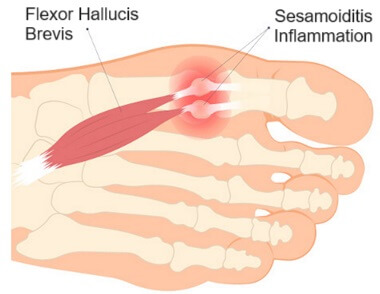
The sesamoid bones of the foot are two small pea-sized bones that sit within the flexor hallucis brevis tendon, the tendon that runs underneath the big toe.
The foot sesamoid bones help to bear weight, provide stability, absorb shock, reduce friction and distribute the load when you walk, run, or engage in any activities that involve pushing off the ground with your toes.
These small bones play a crucial role in the function of the foot and are involved in various movements, especially in activities that require bending the big toe and supporting body weight.
Repetitive friction and pressure through the sesamoid bones leads to inflammation of the sesamoid bones and their surrounding tendon. This is known as sesamoiditis and is a type of foot tendonitis.
What Causes Sesamoiditis?
Sesamoiditis foot pain is typically caused by excessive or repetitive stress on the sesamoid bones and the tendons surrounding them. Common causes of foot sesamoiditis include:
- Overuse or High-Impact Activities: Engaging in activities that place repeated stress on the forefoot can lead to sesamoiditis. This includes sports like running, dancing, and activities that involve pushing off with the toes. The constant impact and pressure on the sesamoid bones can cause irritation and inflammation.
- Trauma: Direct injury or trauma to the foot, such as a fall or having a heavy object land on the foot, can lead to sesamoiditis. Trauma can cause damage to the sesamoid bones or the surrounding structures, triggering pain and inflammation.
- Improper Footwear: Wearing shoes that lack proper cushioning and support can increase the risk of sesamoiditis. High heels, in particular, can place excessive pressure on the forefoot, contributing to the development of sesamoiditis foot.
- Foot Structure: Certain foot types and structural abnormalities can make individuals more susceptible to sesamoiditis. For example, having a high arch (cavus foot) can alter the distribution of weight on the forefoot and increase the risk of sesamoid issues.
- Excessive Weight and Body Mass: Being overweight or obese can increase the pressure on the feet, including the sesamoid bones, potentially leading to sesamoiditis.
- Tight or Inflexible Tendons: Tendons that are tight or lack flexibility can place additional strain on the sesamoid bones, making them more prone to inflammation.
- Gout: In some cases, sesamoiditis can develop as a side effect of gout, a condition where uric acid crystals build-up in the big toe causing redness, inflammation and intense pain
Sesamoiditis Symptoms
Common symptoms of foot sesamoiditis include:
- Pain: The most common and prominent symptom of sesamoiditis is foot pain. This pain is typically localized to the ball of the foot, specifically beneath the big toe joint. It can range from mild discomfort to intense, sharp big toe pain. Sesamoiditis pain usually develops gradually over time, rather than suddenly.
- Swelling & Bruising: Inflammation often accompanies sesamoiditis, leading to swelling in the affected area. There may also be some localised bruising.
- Tenderness: The area around the sesamoid bones often becomes tender to the touch. Pressing on the ball of the foot near the big toe joint can elicit sesamoid pain and discomfort.
- Difficulty Moving the Big Toe: Sesamoiditis can result in restricted movement of the big toe. It may be painful or uncomfortable to bend or move the big toe, particularly when pushing off with the foot, e.g. during walking or running.
- Pain During Weight-Bearing Activities: Sesamoiditis pain is often aggravated when weight is placed on the affected foot. Activities that involve pushing off with the toes, such as running or dancing, can exacerbate the discomfort.
- Pain When Wearing Tight Shoes: Shoes that put pressure on the forefoot can increase sesamoiditis pain. High heels, in particular, can be problematic due to the added pressure on the sesamoid bones.
It's important to note that sesamoiditis symptoms can vary in intensity and may come and go.
Diagnosis
Diagnosing sesamoiditis involves a combination of a physical examination, discussion of symptoms, and, in some cases, the use of imaging tests.
The process usually begins with a detailed medical history. Your healthcare provider will ask about your symptoms, when they started, and whether there was any specific event or activity that might have triggered the pain. Information about your physical activities, footwear, and any prior foot injuries is also relevant.
They will also conduct a physical examination of your foot. They will palpate the area around the big toe joint, specifically the ball of the foot where the sesamoid bones are located. The presence of tenderness and pain upon touch is a significant indicator of sesamoiditis. They will also assess the range of motion in your big toe to see if there is any restriction to movement. They may also assess the whole foot to rule out other possible conditions.
In some cases, to confirm the diagnosis and rule out other potential issues, you may be sent for imaging tests. The most common imaging tests used for diagnosing sesamoiditis include:
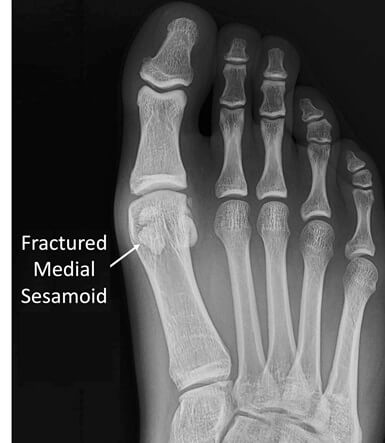
X-rays: can show the condition of the sesamoid bones and any abnormalities, such as fractures, dislocation, or degeneration. Sesamoiditis typically does not cause visible changes on X-rays, but these images are valuable for excluding other conditions.
Magnetic Resonance Imaging: an MRI may be recommended to provide a more detailed view of the soft tissues, tendons, and sesamoid bones. This helps confirm any inflammation or other soft tissue issues.
Bone Scan: will show any areas of irritation in the sesamoid bone.
Once the healthcare provider has gathered all the necessary information from the examination and imaging, they can make a definitive diagnosis.
Differential Diagnosis
While sesamoiditis is a common cause of pain in the ball of the foot, there are several other foot-related conditions that could have similar symptoms:
- Sesamoid Fractures: Sesamoid bones can fracture due to trauma or excessive stress, leading to pain and swelling in the same area. An X-ray can distinguish between a sesamoid fracture and sesamoiditis.
- Turf Toe: Turf toe is a sprain of the ligaments around the big toe joint and can result in pain, swelling, and limited range of motion. It often occurs in athletes involved in activities like football. Find Out More >
- Metatarsalgia: Metatarsalgia is a condition characterized by pain and inflammation in the metatarsal bones of the foot, typically occurring in the ball of the foot. Find Out More >
- Arthritis: Arthritis, particularly osteoarthritis or rheumatoid arthritis, can affect the big toe joint, known as hallux rigidus, and cause pain and stiffness. Find Out More >
- Morton's Neuroma: Morton's neuroma is a condition in which the tissue around a nerve leading to the toes becomes thickened. It can cause pain and discomfort in the ball of the foot. Find Out More >
- Bursitis: Bursitis in the foot, particularly in the area around the big toe joint, can lead to pain and swelling.
- Gout: Gout is a form of arthritis that can cause sudden and severe pain, often in the big toe joint. It is associated with the build-up of uric acid crystals. Find Out More >
- Stress Fractures: Stress fractures in the metatarsal bones or other foot bones can cause localized pain, and the symptoms can be similar to those of sesamoiditis. Find Out More >
Sesamoiditis Treatment
The treatment of sesamoiditis typically involves a combination of conservative measures aimed at relieving pain, reducing inflammation, and promoting healing. In most cases, surgical intervention is not necessary, and these non-invasive approaches can be highly effective.
#CommissionEarned from Amazon on qualifying purchases
Common treatment options for sesamoiditis include:
- Rest: Reducing or avoiding activities that place stress on the affected foot is crucial. This allows the sesamoid bones and the surrounding tissues to heal. Staying off the foot and using crutches may be necessary in severe cases for a few days/weeks.
- Icing: Applying ice to the affected area for 15-20 minutes several times a day can help reduce sesamoiditis pain and inflammation. Use a thin cloth or towel to avoid direct contact between the ice and your skin to reduce the risk of ice burn.
- Orthotic Inserts: Custom or over-the-counter orthotic shoe inserts can provide additional support and cushioning for the foot, redistributing pressure and reducing the strain on the sesamoid bones. If you are looking for something smaller, metatarsal pads are a great option.
- Footwear: Wearing well-cushioned, supportive shoes with a wide toe box can help alleviate pressure on the forefoot and promote proper foot mechanics.
- Medication: Over-the-counter pain relievers e.g. paracetamol/acetaminophen or non-steroidal anti-inflammatory drugs (NSAIDs) e.g. ibuprofen/Advil may be recommended by your healthcare provider to manage sesamoiditis pain and reduce inflammation.
- Physical Therapy: Physical therapy is a crucial component of sesamoiditis treatment. A physical therapist can develop a tailored exercise program to improve the strength and flexibility of the foot, ankle, and toes. Foot strengthening and stretching exercises can help you regain mobility and reduce pain.
- Taping: Sesamoiditis taping of the big toe or using special taping techniques can provide additional support to the sesamoid bones and reduce strain during movement.
- Casting or Bracing: In severe cases or when conservative treatments are ineffective, you may need to wear a short-term cast or brace to immobilize the foot, allowing the sesamoid bones to heal.
- Steroid Injections: Corticosteroid injections can help to reduce pain and inflammation from foot sesamoiditis. However, this is not typically a first-line treatment due to potential side effects and the risk of tendon weakening.
The success of sesamoiditis treatment often depends on early diagnosis and adherence to the recommended interventions. With proper care and rest, many individuals can experience significant relief from sesamoiditis and return to their regular activities without any foot pain.
Surgery For Sesamoiditis
Surgical intervention for sesamoiditis is typically considered a last resort and is not commonly needed unless conservative treatment methods have failed to resolve symptoms. There are a few different surgical options for sesamoiditis:
1. Sesamoid Removal
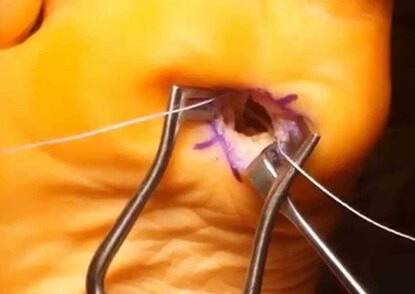
Sesamoid removal is the most common surgical procedure for sesamoiditis, aka sesamoidectomy.
During a sesamoidectomy, the problematic sesamoid bone is surgically removed.
This procedure is performed under local or general anaesthesia and is typically considered when all other treatments have proven ineffective, and the pain is significantly impacting the individual's quality of life.
Recovery: After a sesamoidectomy, a period of rest and immobilization is required to allow the foot time to heal. Crutches and a walking boot may be necessary for a few weeks. Physical therapy can help restore strength and flexibility in the foot. Over time, the foot adapts to the absence of the sesamoid bone, and most individuals can return to normal activities.
Possible Consequences: Removing a sesamoid bone can alter the mechanics of the big toe joint and the surrounding tendons. This procedure can lead to changes in gait and push-off power in the foot. Some individuals may experience stiffness or reduced strength in the big toe, which is why sesamoidectomy is reserved for severe and persistent cases.
2. Sesamoid Bone Repair
In some cases, rather than removing the sesamoid bone, surgical repair may be attempted. This procedure is less common and typically involves stabilizing or repositioning the sesamoid bone or addressing damage to the surrounding structures.
Recovery: Recovery from sesamoid bone repair surgery may vary depending on the specific procedure performed. Similar to sesamoidectomy, rest, immobilization, and physical therapy are often necessary.
3. Fusion (Arthrodesis)
In extremely rare cases where all other treatments have failed and there is severe damage to the sesamoid bones and surrounding joints, fusion of the big toe joint (arthrodesis) may be considered. This procedure involves fusing the bones in the big toe joint to eliminate movement and reduce pain.
Recovery: Recovery from arthrodesis is more involved and can require an extended period of immobility and rehabilitation. After the procedure, you'll likely need to wear a cast, and weight-bearing may be limited for an extended time.
Sesamoid Pain Summary
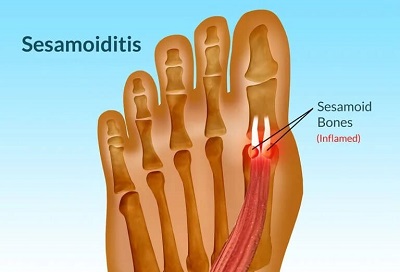
Sesamoiditis is a type of foot tendonitis caused by inflammation of the sesamoid bones and surrounding tendon.
Common causes of sesamoiditis include repetitive overuse, tight footwear, altered foot biomechanics, obesity and foot injuries.
Sesamoiditis often affects athletes who do activities such as running (especially sprinters), dancing, football and baseball (especially pitchers).
The function of a sesamoid bone is to increase leverage and improve mechanical advantage as well as reduce tension, absorb stress and redistribute weight-bearing forces.
Common symptoms of foot sesamoiditis include pain underneath the big toe, localised bruising and swelling, difficulty walking or running and stiffness in the big toe.
There are a number of other conditions that can present in a similar way to sesamoiditis causing big toe pain including hallux rigidus, gout and turf toe.
Foot sesamoiditis treatment typically involves a combination of rest, ice, stretching and strengthening exercises, orthotics and appropriate footwear.
You may also be interested in the following articles:
- Ball Of Foot Pain
- Foot Arch Pain
- Inner Foot Pain
- Pain On Top Of Foot
- Sharp Pain Big Toe
- Nerve Pain In The Foot
Related Articles
Page Last Updated: 2nd October, 2024
Next Review Due: 2nd October, 2026
